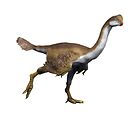Canadaga
| Canadaga Temporal range: Late Cretaceous,
| |
|---|---|
| Scientific classification | |
| Kingdom: | Animalia |
| Phylum: | Chordata |
| Clade: | Dinosauria |
| Clade: | Saurischia |
| Clade: | Theropoda |
| Clade: | Avialae |
| Clade: | †Hesperornithes |
| Family: | †Hesperornithidae |
| Genus: | †Canadaga Hou, 1999 |
| Species: | †C. arctica
|
| Binomial name | |
| †Canadaga arctica Hou, 1999
| |
Canadaga (meaning "Canadian bird"[1]) is a flightless bird genus from the Late Cretaceous. The single known species is Canadaga arctica. It lived in the shallow seas around what today is Bylot Island in Nunavut, Canada. Its fossils were found in rocks dated to the mid-Maastrichtian age, about 67 million years ago.[2]
It was a member of the Hesperornithes, flightless toothed seabirds of the Cretaceous. Among these, it belonged to the Hesperornithidae, along with Hesperornis, the well-known namesake genus.[3]
C. arctica is one of the largest known members of the Hesperornithes, reaching a length of 1.5 metres (4.9 ft). It also represents one of the last known members of the lineage.[1] Unlike its relatives which are mainly known from subtropical or tropical waters, this species seems to have ranged in temperate or even subarctic areas.
The species is described from 3 associated cervical vertebrae, one caudal vertebra and two femurs.[2]
References[]
- ^ a b Holtz, Thomas R. Jr. (2008) Dinosaurs: The Most Complete, Up-to-Date Encyclopedia for Dinosaur Lovers of All Ages Winter 2010 Supplementary Information
- ^ a b Hou L.-H. (1999). "New hesperornithid (Aves) from the Canadian Arctic" (PDF). Vertebrata PalAsiatica. 37 (7): 228–233. Archived from the original (PDF) on 2014-08-08.
- ^ Mortimer, M. (2004). The Theropod Database: Phylogeny of taxa Archived May 16, 2013, at the Wayback Machine. Retrieved 2013-MAR-02.
- Bird genera
- Late Cretaceous birds of North America
- Hesperornitheans
- Extinct flightless birds
- Prehistoric bird stubs















